8 Ball Pool Rules
The rules for 8 Ball Pool can be confusing, as there are several international variations. When playing informally - for example, with friends - this can lead to disagreements over the correct ruling in a given situation. This page will clarify the various different pool rules and prevent confusion.
There are three sets of rules for 8 Ball Pool which are most commonly played:
WPA Blackball Rules - Played with 2” red/yellow balls.
WEPF World Eightball Pool Rules - Played with 2” red/yellow balls.
WPA Eight Ball Rules - Played with 2 1/4” spots/stripes balls.
Blackball is the most common rule set in the UK and Ireland, and is known usually as "pool" due to its prevalence.
Also included here are the newest set of rules for 8 Ball Pool, Supreme Pool Rules, which are currently used in the Supreme Pool Series, sponsored by Home Leisure Direct.
At Home Leisure Direct we are Europe’s largest pool table retailer, and consider ourselves to be experts on all aspects of 8 Ball Pool. We carry huge stocks of many different tables all year round, including many exclusive tables from some of the world’s greatest manufacturers. We also have the largest showrooms in Europe, with a huge number of pool tables on display. If you would like to know more about us, please see our About Us page.
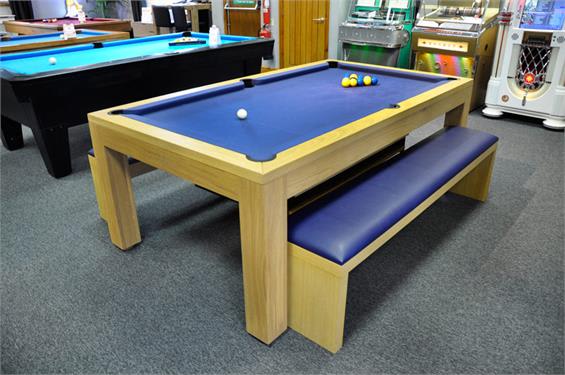
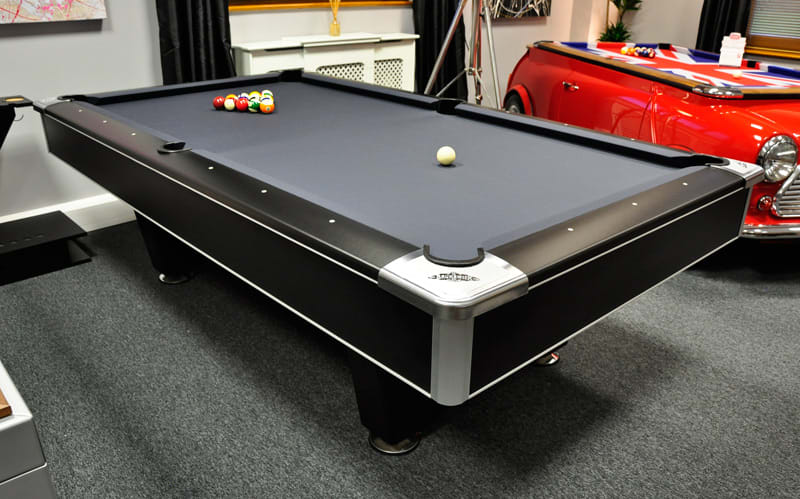
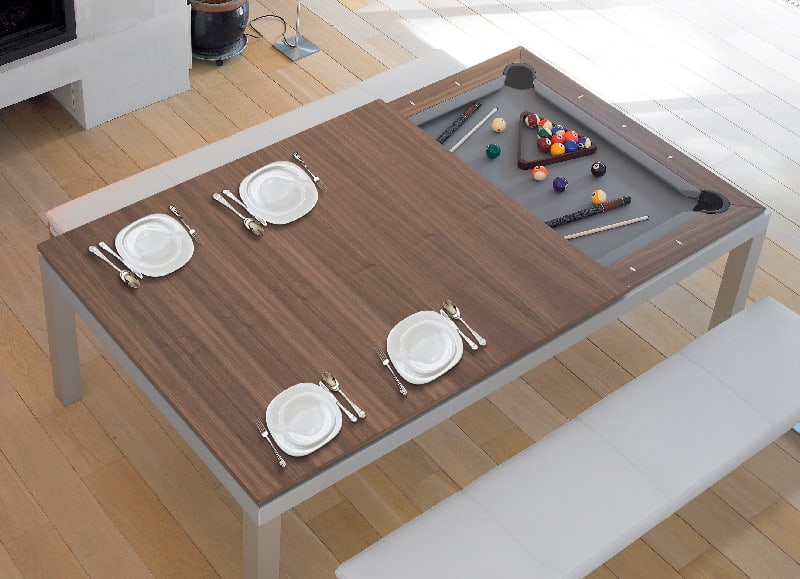
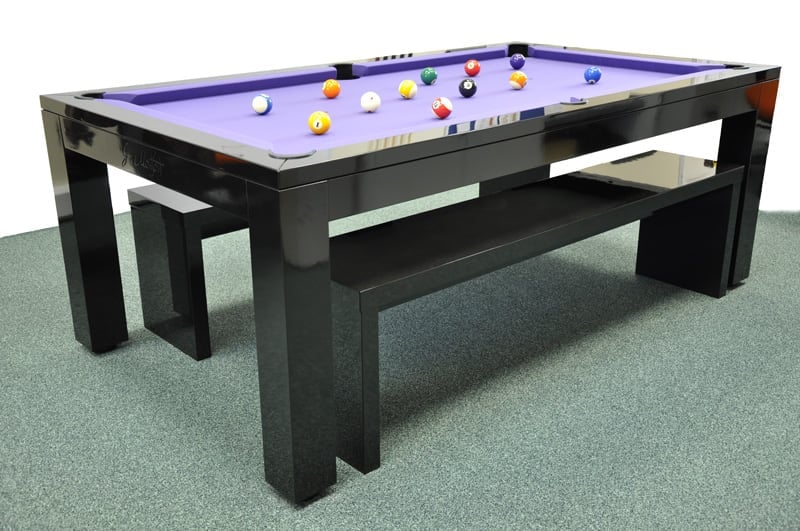
English Pool Tables American Pool Tables Pool Dining Tables Luxury Pool Tables
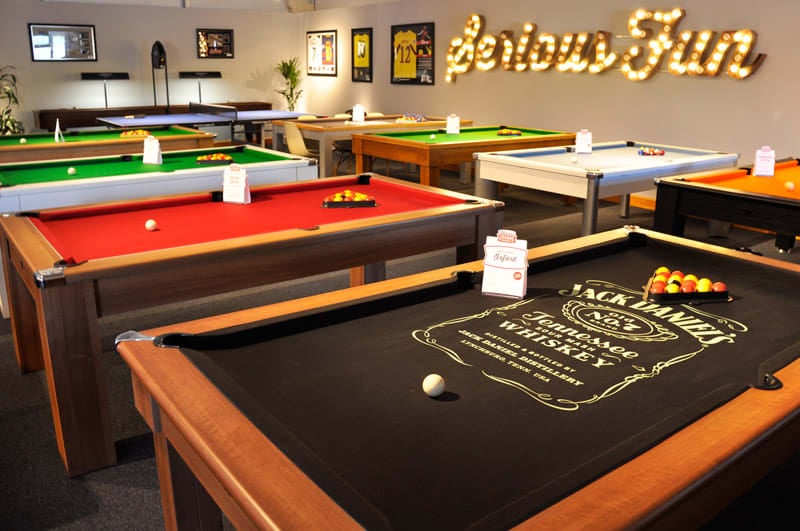
We always have a fantastic stock of tables in our showrooms. Why not check out our Showroom Tour to see for yourself?
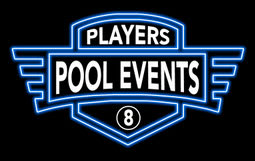
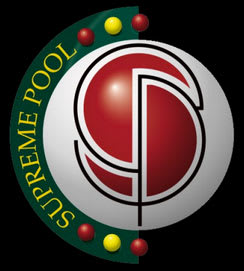
SUPREME POOL RULES:
1 - SPIRIT OF THE GAME
The game shall be known as Supreme Pool. Supreme rules should be played in a sporting manner at all times.
2 - EQUIPMENT & TABLE LAYOUT
All equipment that is generally accepted throughout the industry is permitted. No other equipment is allowed unless ratified by the Tournament Director.
However, using any equipment in a non-customary manner is never allowed and constitutes a foul.
Supreme Pool is played on a six pocket rectangular table with six cushions.
Equipment permitted:
- A spotted white called a cue ball
- Two groups of object balls consisting of seven reds and seven yellows
- A striped eight ball
- Spider, rest, gooseneck rest, cross rest
- Prescribed cues
The playing surface is the flat part of the table bordered by the cushions.
The surface should be marked with an eight ball spot at the intersection of two imaginary diagonal lines joining the centre and corner pockets.
The surface should be marked with a ‘T’ racking marker. The 60mm parallel of the T going through the top spot for top ball of the rack parallel to the top cushion and the 280mm vertical line going down through the eight ball spot towards the top cushion (See Rule 5 for an illustration of the ’T’ Marker).
The cloth is marked with a break line parallel to the bottom cushion 1/5th of the length of the table away from baulk cushion.
3 - THE OBJECT OF THE GAME
Supreme pool is played with a spotted cue ball and fifteen object balls, seven red, seven yellow and a striped eight ball.
One player must pocket all balls of one group, while the other player must pocket the alternate coloured balls. The player who pockets their entire group and THEN legally pockets the eight ball wins the game. The eight ball must be potted in a separate shot.
4 - THE BREAK
4a - A “Lag for Break” shall determine who breaks first with an alternating break format taking place thereafter. The winner of lag is the player whose ball is closest to baulk cushion. The winner of the lag is given the choice to break or not.
4b - Lagging Procedure:
- Balls shall be of equal size and weight
- To start the lag the referee will count the players in by counting back from 3 to 1.
- The players must simultaneously strike balls on the referee’s indication towards the top cushion.
4c - It is automatic loss of lag if a ball:
- Crosses into the opponent’s half of the table.
- Fails to contact the top cushion.
- Drops into a pocket.
- Hits a side cushion.
- Jumps from the table.
- Comes to rest on the playing surface within the area of the corner pocket.
- Player commits any standard foul.
4d - Players will lag again if:
- Both players foul.
- The referee cannot decide on which is closest to the bottom cushion.
- The referee calls a VOID LAG because one player's ball strikes the top cushion before the other player’s ball is hit.
4e - The Break will be deemed a "Legal Break" if:
- At least one group is potted.
- Four object balls (minimum) are driven to a cushion.
4f - Failure to perform a legal break MUST result in a re-rack. The opponent has the option to break or to choose to give the break back to the original breaker.
4g - Groups are not decided on the break. Table remains open after the break. If player in control of the table does not make a legal pot table is still deemed open for the incoming player.
4h - If the eight ball is potted off the break, it is re-spotted if:
One or more of the groups are also potted, the breaker keeps control of the table and continues visit.
No group is potted, the breaker loses control of table.
To re-spot the eight ball, the centre point of the eight ball is placed on the eight ball spot or if this is not available as near as possible to the spot in a direct line between the spot and the centre of the top cushion.
If there is no space available on this line, place the eight ball as near as possible to its spot in a direct line between the spot and the baulk cushion.
4i - “In - off " on a legal break results in the incoming player being awarded one visit with cue ball to be played from behind the break line, in any direction.
5 - THE RACK
Arrange as shown with the eight ball on the eight ball spot. Top apex ball on the centre of ’T' marker. (See the diagram for an illustration of where the balls should be racked in relation to the 'T' Marker).
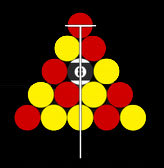
6 - IN PLAY
6a - Deciding groups
- Groups are decided on the first ball legally potted. Referee will call first group in play. See 6e(13)
- The table is always open immediately after the break shot. Balls potted from the break are disregarded. The player’s designated group (red or yellow) will not be determined until a player legally pockets an object ball. The table is considered an “open” table when the choice of groups (red or yellow) has not yet been determined.
- Failure to make a legal pot result in the table remaining open.
- If one of each group is potted in one shot, the player will be 'on' the group struck by the cue ball first unless a foul has occurred, in which case the table remains open.
- Where the choice of group is not obvious. (e.g. player cues up to a group of object balls/object balls of both groups sitting close to each other/player is snookered behind the eight ball/the lay of the table is such no object ball is a clear target).
- a) The player MUST indicate to the referee and/or the opponent the intended group.
- b) Failure to strike called group is loss of turn, table remains open.
- c) Striking called group but potting other group is loss of turn, table remains open.
- d) Potting called group is a legal pot and group is assigned to striker.
- e) The onus is on the player in control of the table to make the call in order for the groups to be decided in a fair and sporting manner.
- Simultaneous contact is allowed so in the case of a 50/50 ball the player will be deemed to be 'on' the called group.
- Groups are not decided on a foul shot.
6b - Completing a frame
In the course of play if the balls are potted and a legal shot is played, the players are entitled to an additional shot.
Play continues until a player:
- (a) Fails to pot one or more of the allotted balls and/or
- (b) Commits a foul.
6c - Combination shots
Two or more object balls can be potted without penalty in a single 'combination' shot. The potted balls may drop into the pockets in any order but 'on' ball must be struck legally first.
Attempting to complete a combination shot that results in only potting ball not 'on' is LOSS OF TURN.
Combination shots do not have to be called.
6d - Loss of turn
As long as the player strikes an 'on' ball first, should an opponent’s ball be potted, it will be loss of turn.
Control of the table returns to the opponent; cue ball is played from where it lies.
For example:
Potting an opponent's ball accidentally.
Failing to complete a legal combination shot.
A tactical shot e.g. playing designated group legally to pot an opponent’s ball.
6e - Standard fouls
Standard fouls are to be called by the referee as soon as they occur, the fouled player is in control, until all balls from that shot come to rest.
The referee then awards cue ball in hand, can be placed anywhere on the table with one visit to the opponent.
- Potting the Cue Ball - "In Off" (Except off the break, see 4i)
- Playing from outside Baulk when obliged to play from Baulk. The break line is considered to be part of the baulk. The base of the cue ball must be on or behind the break line.
- A player who plays a shot immediately after playing a foul or immediately after the referee has called a foul on that player, has played out of turn. This also covers breaking out of turn.
- Striking the Cue Ball with any part of the cue other than the tip in general play. Positioning the cue ball with the cue after a foul is allowed as long as the tip of the cue is not used.
- Striking an Object Ball with any part of the cue or cue tip.
- Playing a shot before all balls have come to rest from the previous shot.
- Playing a shot before any balls that require re-spotting or replacing, have been re-spotted or replaced. (See 6l).
- Coaching: During a frame, a player is required to play without receiving any advice from other persons relating to the playing of the frame. Should a team member or bone-fide supporter of a player offer advice, the referee will issue a "First and final warning" to that person that a repetition will result in the player being penalised via a Standard Foul. Because it may not always be possible for the Referee to hear if a statement made to a player is advice, the referee may issue the first and final warning on the grounds that any statement made to a player, other than general barracking, is deemed to be coaching. In a tournament setting, a First and Final warning may be given once only, before the commencement of the day's play as a block warning to all players and spectators.
- Leaving the playing area without permission. If a player needs to leave the playing area during a frame or match, "Time Out" must firstly be granted by the referee. Timeout may be called for:
- (a) Player requests a rest or bridge.
- (b) Something or someone is obstructing the player.
- (c) The referee has to make a decision.
- (d) The referee has to replace or re-spot a ball.
- Playing a shot after neglecting to call choice of group when required to do so by a referee / opponent. See Rule 6a(5).
- Playing a “Push Shot” (defined as when the tip of the cue remaining in contact with the cue ball once it has commenced a forward motion).
- Double hit.
- Failing to perform a “Legal Shot”. DEFINITION OF A LEGAL SHOT - To play a legal shot the player must cause the cue balls initial contact to be with a ball 'on' and THEN must either:
- Pot any ball or balls or
- Cause the cue ball or any object ball to contact a cushion.
- Playing a shot while not having at least one foot touching the floor.
- Failing to "Play Away" from a touching ball(s).
- A ball remaining off the table.
- Players body or clothing touching any ball.
- Jump shot: If the cue ball leaves the bed of the table and does not strike an object ball that it would have struck had the cue ball not left the table on an otherwise identical shot, then the cue ball is deemed to have jumped over that ball.
- Marking the table to assist a shot.
- Time foul.
6f - Loss of frame fouls
- Deliberately striking / potting an opponent’s ball(s).
- Unsporting behaviour / bringing the game into disrepute, including but not exclusive to:
- (a) Foul language.
- (b) Throwing a cue around / unscrewing as if to concede.
- (c) Continually arguing with the referee or opponent.
- (d) Interfering when the opponent is on the shot either verbally or physically.
- Committing a foul in the same shot that the eight ball is potted. (Except on the break)
- Potting the Eight Ball when a ball or balls of the player's own group are still on the table (except on the Break), including potting last group ball and eight ball in same shot.
- A player who clearly and intentionally fails to make an attempt to play a ball(s) of his/her own group.
- Intentionally positioning the cue ball in hand after a foul to create a re-rack situation.
6g - Stalemate situation
Should any situation arise whereby a legal shot cannot be played, Rule 6e(13), whether this situation is arrived at by accident or design, the frame shall be restarted with a 15 ball rack.
The players will re-lag to determine who will break.
6g - Frozen balls
- An object ball is deemed frozen whilst touching a cushion. It is a foul if the shot does not result in:
- A ball being potted or
- The cue ball contacting a cushion or
- The frozen ball contacting a cushion attached to a different rail or
- Any other object ball contacting a cushion with which it was not already in contact with before the shot is played.
- A ball is only deemed frozen if announced by the referee or player, prior to the shot being taken.
6h - Outside Interference
- There is no penalty if balls are moved in these circumstances:
- (a) By persons other than players taking part in the frame or
- (b) As a result of players being bumped or
- (c) Events deemed not within a players control.
- The referee will return the balls as close as possible to their original positions whenever possible. Re-racks should only be granted in extreme circumstances. The referee’s decision is final.
- The referee can reset the shot clock if they consider situation warrants. The decision is at referee’s discretion.
6i - Shot clock
Each player is allotted 45 seconds for each shot. The tip of the cue must have made contact with the cue ball within this time or a standard foul shall be granted to the opponent. The shot clock is to be started once all balls come to rest. The time keeper shall call at 10 second mark has been reached, then count down from 5 seconds.
One extension per frame is permitted per player. Referee will reset clock at time of request to 45 seconds.
6j - Balls falling into a pocket without being hit
If an object ball hangs in a pocket and drops in 5 seconds or less after coming to complete rest by the hole, the ball is considered to be pocketed. If a hanging ball drops in the pocket after being at rest for more than 5 seconds, the ball is returned to the original position on the edge, and the incoming player may begin his/her inning. The referee’s decision is final.
If a ball falls into a pocket without being no part of any shot in progress it shall be replaced and play continued.
If a ball falls into a pocket by itself during a shot so that it would have been hit by another ball had that ball still been there, all balls are to be replaced to their original positions before the shot was taken and the player then may replay the shot or choose a different shot if they so wish.
6k - Balls off the table
It is a foul if a ball leaves the playing surface and does not return by its own means and remains off the playing surface (other than being potted)
- If a cue ball it is ball in hand, can be played anywhere on the table.
- Object balls are re-spotted.
6l - Re-spotting and returning balls to the table
An object ball is re-spotted with its centre point on the eight ball spot or as near as possible to that spot in a direct line between the spot and the centre point of the top cushion.
Object balls are re-spotted in the following order:
- (a) Eight ball
- (b) Red
- (c) Yellow
Return balls as close as possible to other balls without touching.
6m - Player responsibility
It is the responsibility of each player to be aware of all rules. However, a referee on request may advise on the rules of the game but must not provide any subjective opinion that would affect the result of the frame. Tournament officials will make every reasonable effort to make the information readily available to all players. However, the ultimate responsibility rests with each individual player. There is no recourse if a player does not obtain correct or complete information.
Players may always call for rule(s) clarification during play. However, this is not considered a “Time Out”.
7 - COMPLETION OF A FRAME
A frame is over when the eight ball is potted on a legal shot and all the balls have come to rest or in a loss of frame situation.
The referee waits for all the balls to stop moving and announces FRAME. If the referee has not made this announcement, then a player will be penalised by LOSS OF FRAME if a further shot is played or the player interferes with the remaining balls.
 Download Supreme Pool Rules...
Download Supreme Pool Rules...

WPA BLACKBALL RULES:
1. Setting Up Balls And Breaking Off
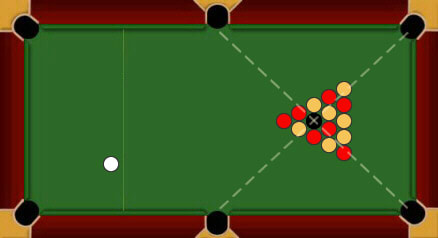
Rack the balls with the black ball positioned at the intersection of two imaginary diagonal lines. The lag winner decides who breaks. Opposing players break alternately in successive frames. Position the cue ball anywhere within baulk.
The centre of the cue ball may be placed directly above the baulk line.
2. Legal And Illegal Breaks
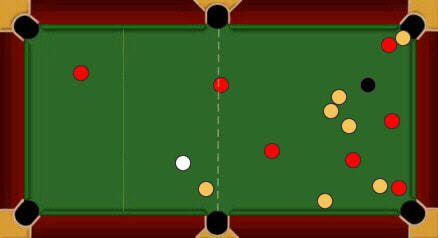
To achieve a legal break at least two object balls (reds, yellows or black) must completely cross an imaginary line joining the middle pockets. Alternatively, at least one ball must be potted.
If no balls are potted and two object balls do not pass over this line, then the oncoming player is awarded 'one free shot and one visit'.
The cue ball may then be played from where it lies or from baulk. Alternatively, the oncoming player may request a re-rack. It is also a foul if the cue ball is potted on the break. The retrieved white must be played from baulk. If the black is potted the table is set up again and the same player breaks.
On a break shot, no matter the outcome, the table remains 'open'. Groups are never decided on the break. There is no 'nomination' of groups with blackball pool rules.
3. Open Tables And Determining Groups
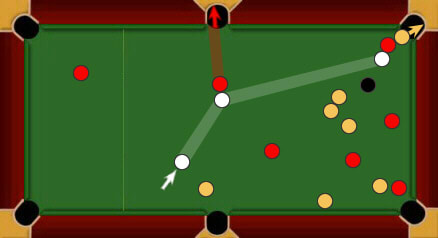
With an 'open table' the designated group (that is whether a player continues on red or yellow balls) is NOT determined in the following situations...
On the break shot.
When a foul is played on a shot.
When taking a free shot after a foul.
Where a combination shot is played in which balls from both groups are potted.
With the exception of those aforementioned situations, if a player pots a ball or balls from a single group the player is then 'on' that group for the duration of the frame. So, above, potting only the red in the middle pocket would determine 'reds' as that player's group; but pot both red and yellow in a combination shot and the table remains open.
4. Play Either Group On Open Table
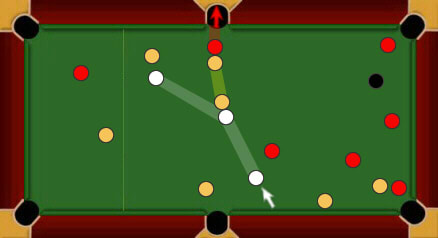
If an 'open table' (that is groups have not been decided) players may play the cue ball to strike a ball from either group (reds or yellows).
In this scenario, with an open table, a yellow ball has been played directly onto a red which in turn drops into the pocket.
That player's group then becomes reds.
A number of exceptions are described at '3' above in which an open table situation could continue.
Also note above, if the red had fallen short of the pocket and no balls struck a cushion the shot would not be 'legal' and a foul would be called (see further examples of legal and illegal shots, below.)
Remember that the black cannot be used as a ball to pot another object ball unless a foul has been committed and a 'free shot' has been awarded to the oncoming player.
5. Legal Shot Defined
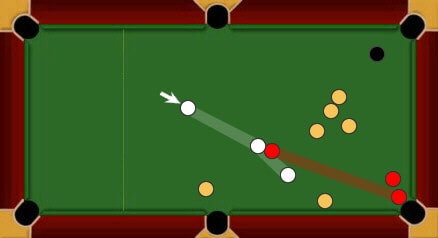
To play a legal shot a player must cause the cue balls initial contact to be with an 'on' ball and THEN....
(a) Pot any 'on' ball or balls, OR...
(b) Cause the cue ball or any other ball to contact a cushion.
An 'on' ball might include balls from either group or the black if a player has a 'free shot'. In the situation above, if the red ball falls short of the pocket and no ball strikes a cushion after the cue ball hits the red, then the referee calls a foul. There is one exception to this definition... escaping from a snooker, which is described below.
6. Snooker Defined
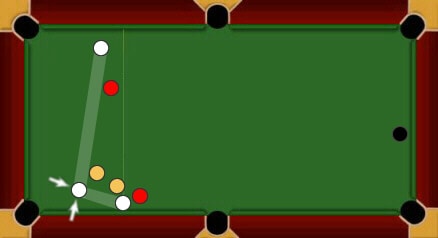
A player is 'snookered' when it is deemed impossible to strike any part of an 'on' ball by way of a straight line shot... which is the case in the these examples. Players should seek confirmation that it is a 'full snooker' from an opposing player, a referee or other official before attempting to play out of a snooker.
7. Legal Shots And Laying Snookers
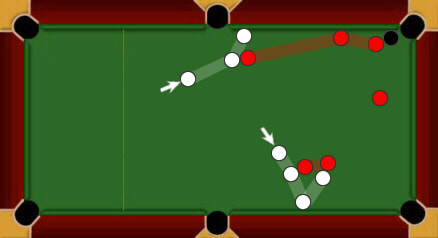
A direct consequence of the need for a ball to strike a cushion after contact with an 'on' ball is that it is not possible to simple tap up behind a ball to lay a snooker.
Here, in the upper shot, to lay a snooker on the black ball, either the cue ball or the red must touch a cushion after the red after has been struck.
Similarly, in the second scenario, the white gently glances against a red ball before it hits the cushion. This results in a snooker behind two reds. In this case, because it initially touched a red ball, the cue ball need not necessarily reach the two reds before it comes to rest behind them off the cushion.
8. Legal Shots And Escaping Snookers
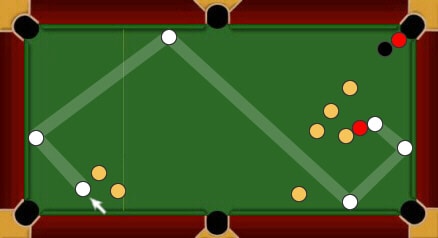
There's an exception to the requirements of a legal shot as defined at '5' above.
When successfully escaping a snooker, as in the diagram, it is not necessary for a ball to touch a cushion after the object ball has been struck.
It is sufficient for the cue ball to simply make contact with an 'on' ball.
It follows that in escaping a full snooker by way of a 'swerve' on the cue ball, it is not necessary for any balls to strike a cushion during the successful execution of such a shot.
9. Balls Leaving The Table
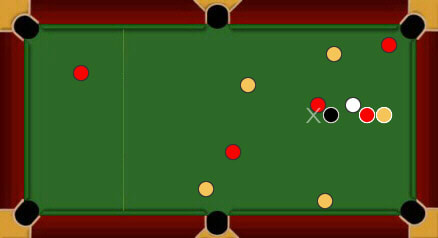
At any stage in the game, balls which leave the table are returned to the playing surface.
If the cue ball, then it's played from baulk.
Balls are always 're-spotted' on, or as close as possible to, the black spot in a direct line between the spot and the end cushion which is closest to that spot.
Above, three object balls (red, yellow and black) had left the table on the break. In this case, with an 'open table', object balls are replaced in order of black, red and yellow. Return balls to the playing surface in a straight line, as close as possible, without touching.
When not an open table a black ball is again always returned first but is followed by any ball or balls from the group of the player just about to play... that is of the 'on' player.
10. Combination Shots Explained
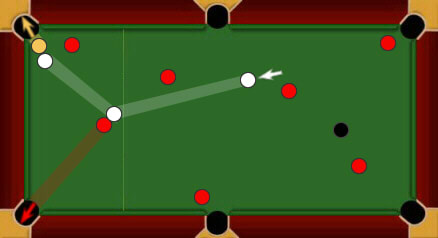
Two or more object balls can be potted without penalty in a single shot. These may be balls from both groups and could include the black ball.
In such shots the balls can drop into pockets in any order.
The object ball with which the cue ball makes initial contact must be a ball which can be legally struck.
A combination shot might be used to clear an opponent's ball which is 'blocking' a pocket. In the situation depicted the player on reds plays a combination. Sinking both the red and yellow creates an opportunity for the player on red balls to clear the table.
11. Frame Winning Combination Shot
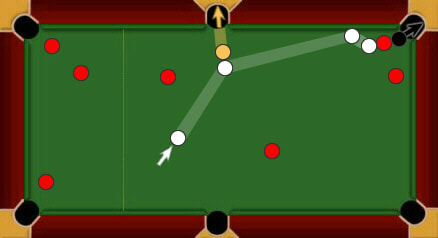
Players may sink their last remaining group ball (or balls) and the black in the same shot and so win a frame.
Initial contact, as always, must be with an 'on' ball.
In this instance the player on yellows pots the final yellow ball and in the same combination shot wins the frame by potting the black ball.
12. Same Pocket Combination
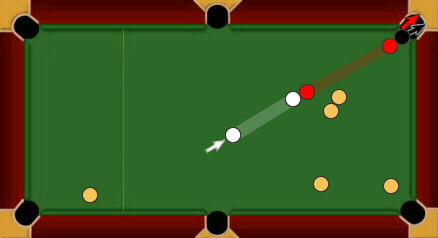
In certain circumstances a combination shot can be played in which two balls are potted in a single pocket.
In this example the red ball is struck and directed in such a way as to pot the black and then to follow through to drop into the same bag and clinch the frame.
13. Combination On A Free Shot
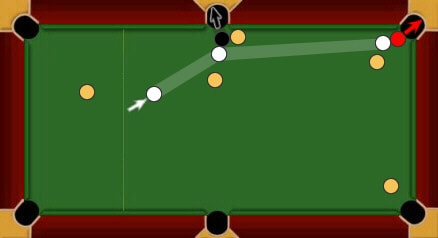
After a foul the oncoming player has a 'free shot' and may play onto any object ball on the table.
Here, the player on reds may legally strike and pot the black ball and then, in the same shot, sink the last remaining group ball to win.
Potting only the black would of course result in loss of frame.
14. Play Away From Touching Ball

It is necessary to play away from any object ball declared to be touching the cue ball.
If, in doing so, the touched object ball moves, then it is a foul.
If the cue ball is touching a ball from your own group (or indeed any 'on' ball) then that object ball is regarded as having been 'struck'.
When playing away from a touching ball it is necessary to meet the requirements of a legal shot. That is a ball must be potted or a ball strike a cushion. Above the player is on reds. The cue ball is deemed to have struck the touching red. The player takes advantage of this opportunity by playing the cue ball onto the cushion and laying a snooker.
If playing away from a touching ball 'not on' the requirements of a legal shot must be met plus the initial contact of the cue ball, on playing the shot, must be with an 'on' ball.
15. Another Touching Ball Situation
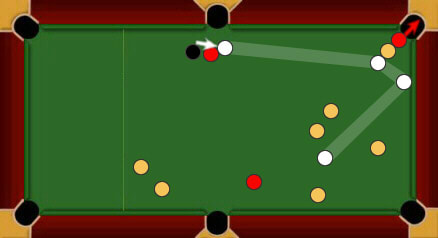
In this scenario the cue ball is touching a red ball. The player is 'on' reds and is considered to have struck the touching ball when playing the shot.
By striking the yellow it's possible to sink the red over the pocket. The player then has an excellent opportunity of winning the frame.
16. Free Shot After A Foul
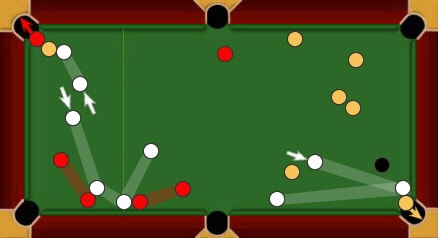
Following a foul the table is declared 'open' and the oncoming player takes a 'free' shot.
In doing so it is permissible to play onto any object ball. Any ball may be potted, including the black if it is 'on'.
In each of the three situations, the player taking the free shot is 'on' reds.
To the top left, a shot is legally played on to a yellow to sink a red ball.
Bottom right, an opponent's yellow ball is played to clear the way to pot the black later in the frame.
Finally, bottom left, the player uses a free shot to bring two red balls into play.
17. Loss Of Frame Shots
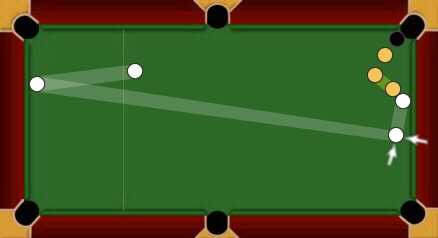
A player who clearly fails to attempt to play an 'on' ball OR deliberately plays a ball which is 'not on' will lose the frame.
The player's group is red in this image. Only the black remains to be potted, but the player is snookered. There is a possible shot, up and down the table, to escape the snooker.
If in playing up and down the player is considered to have made little attempt to make the shot (for example by leaving the cue ball well short) there is a risk of losing the frame for playing a deliberate foul. The decision is with the referee. An alternative call would be a 'standard foul' giving a free shot.
Alternatively, the player could (unwisely) decide to strike the nearest yellow and in doing so open up access to the black. This is undoubtedly a deliberate foul and results in loss of frame.
18. Foul But Not Loss Of Frame
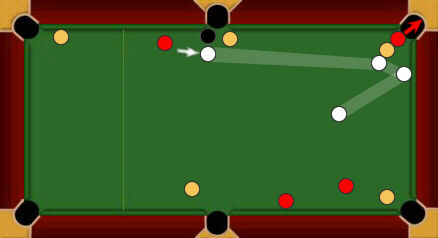
Here the player 'on' yellows intentionally plays a yellow ball onto a red which is potted.
The player was NOT on a 'free' shot.
In striking a ball from his own group first the player has fulfilled the requirements of a legal shot described above.
It is a foul for potting an opponent's ball, but is not loss of frame.
This may be regarded as a tactical option. The player on yellows pots a red in the expectation that, despite the award of a free shot to the opposing player, that player will not finish the frame. The hope is the red balls are so badly positioned the player on yellows becomes the most likely frame winner.
19. Stalemate Defined
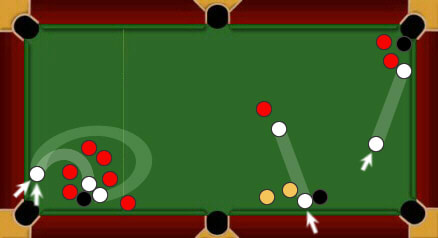
Where no legal shot is playable, whether this be by accident or design, the frame will be re-started.
Top right, the black and two reds remain on the table. The player is 'on' the black. The cue ball cannot pass beyond the reds to strike the black. This is a 'stalemate' and there is a re-rack.
Moving clockwise, the cue ball is touching the black and must be played away from that ball. The player is on reds. However, regardless of the direction in which the cue ball can be played, what matters is the space between black and yellow. If the cue ball is able to pass through that gap then it is theoretically possible to play a legal shot and the player must attempt to do so.
In the final example a legal shot can be attempted, although it's unlikely to be successful. There are two pathways to the black ball between the reds, so it's NOT a stalemate.
 Download WPA Blackball Rules...
Download WPA Blackball Rules...
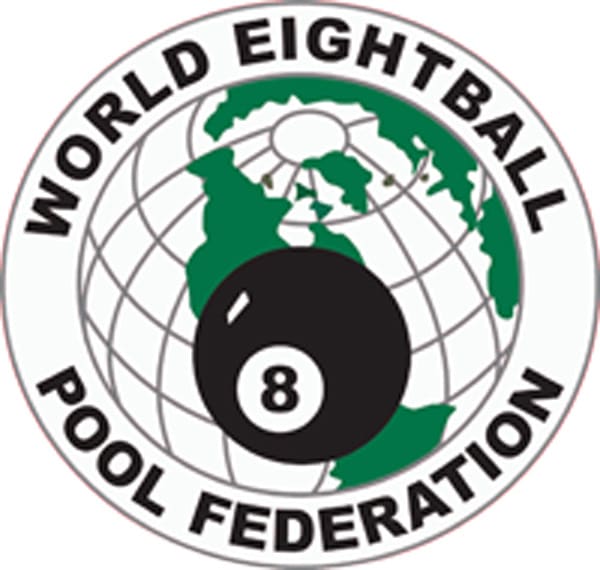
WEPF WORLD EIGHTBALL POOL RULES:
A: The Spirit of the Game
The Game is known as Eight-Ball Pool. It is expected that players will always play the game in the true spirit and in a sporting manner. The Referee will take whatever action is necessary to ensure that the spirit and rules of the game are observed.
B: Equipment
The Game of Eight-Ball Pool is played with:-
1 A "Cue Ball" - being a white ball.
2 Fifteen "Object Balls" - consisting of:-
a "Colours" - being a group of seven red balls, (or balls numbered 1 to 7) and a group of seven yellow balls (or balls numbered 9 to 15).
b The "Eight-Ball" - being a black ball marked with a number "8".
3 A six pocket rectangular Pool Table with general characteristics as follows:-
a The cloth will be marked with a "Spot" at the position where a straight line drawn diagonally from the centre of a side pocket to the centre of a corner pocket would intersect with a straight line drawn diagonally from the centre of the opposite side pocket to the centre of the other corner pocket.
b The cloth will be marked with a "Baulk Line", being a straight line, drawn from cushion to cushion, parallel to, and one fifth of the length of the table from, the face of the cushion that lies the greatest distance from the Spot.
C: Definitions
1 Shot: A "Shot" begins when all balls stop moving from the previous Shot. A player "Plays a Shot" by striking the Cue Ball with the tip of the cue. A "Shot" ends when all balls stop moving from the current Shot.
2 Play: To "Play" an Object Ball is to play a shot that results in the Cue Ball's first contact with another ball to be with that Object Ball. To "Play" the Cue Ball is to strike it with the tip of the cue.
3 Ball On: At any time during a frame, a ball "On" is any Object Ball that the player may play without incurring a penalty.
4 Pot: A ball is "Potted" when it leaves the bed of the table, enters a pocket and remains in that pocket.
5 Visit: A "Visit" comprises one shot or a series of shots. Each visit lasts until the player fails to pot a ball "On". (Or until a foul is committed or the frame ends)
6 Turn: A players "Turn" at the table comprises one visit or, after most fouls committed by the opponent, two visits.
7 Frame: A Frame is one game of Eight-Ball Pool between two players or two pairs of players. A Frame is played from the opening break and usually through until the Eight-Ball is potted. (Note: there are other ways that a frame may end - see "Loss of Frame")
a A player may concede a frame at any time.
8 Match: A Match is a predetermined number of frames of Eight-Ball Pool between two players, two pairs of players or two teams of players.
9 Player in Control: A player (and the player's partner in doubles) is deemed to be "In Control" of the frame from the time that the balls stop moving from the final shot of an opponent's turn until the balls stop moving from the final shot of the player's turn. There can be no instance, once a frame has commenced, that someone is not in control.
D: Object of the Game
1 The object of the game is to win by being the first player to Pot a group of Colours in any order and in any pockets and then Pot the Eight-Ball in any pocket.
2 When "On" a group of Colours, potting more than one ball of that Colour in the same shot is allowed. But a separate shot must be played to pot the Eight-Ball and win the game.
E: Playing from Baulk
1 Baulk is the rectangular area of the table that is bordered by the Baulk Line and the three cushions at that end of the table.
2 When playing from Baulk:-
a The centre point of the Cue Ball must be in Baulk when a shot is played. (If the centre point of the Cue Ball is directly on the Baulk Line it is not deemed to be in Baulk.)
b The Cue Ball can be moved into position by hand or with the shaft of the cue, but when touched by the tip of the cue, a shot is deemed to have been played.
c The Cue Ball may be played in any direction.
d If a player wishes to play from Baulk after a Foul Snooker, Foul Jaw Snooker or "Time Foul":- The player must verbally advise the referee of this choice and the referee will then recover the Cue Ball and hand it to the player or place it on top of, and in the centre of, the cushion at the Baulk end of the table for the player to retrieve by hand.
e After an "In Off", Foul Snooker, Foul Jaw Snooker or "Time Foul" the player must endeavour to position the Cue Ball so as not to create a Foul Snooker. If the player claims a Foul Snooker from Baulk, the referee may choose to move the Cue Ball around to determine if there is any position in Baulk where the player would not be Foul Snookered. Whether such a position is found or not, the referee will announce the result and hand the Cue Ball back to the player or place it on top of, and in the centre of, the cushion at the Baulk end of the table for the player to retrieve by hand.
F: The Break
1 The Object Balls are racked with the Eight-Ball on the Spot.
2 In the absence of any competition / tournament rules to the contrary, a coin will be tossed to determine which player will break. If a series of frames is to be played (A Match), the break of each subsequent frame will alternate.
3 The first shot of a frame is called the "Break". To "Break", the Cue Ball is played at the triangle of Object Balls from Baulk. The frame is deemed to have commenced the instant that the Cue Ball is played
a The Break will be deemed a "Fair Break" if:-
i At least one Colour is potted. AND/OR
ii Four Object Balls (at least) are driven to a cushion.
b If the Break is not a Fair Break it is a Non-Standard Foul and:-
i The opponent is awarded two visits.
ii The balls are re-racked.
iii The opponent re-starts the game and is under the same obligation to achieve a Fair Break.
c
i If the Cue Ball is potted on a Fair Break it is a Non-Standard Foul that is penalised by the turn passing to the opponent.
ii If the break is not a Fair Break and the Cue Ball is potted, the penalty for failure to perform a Fair Break applies. (See (b) above).
4 If the Eight-Ball is potted on any break, the balls are re-racked and the same player will break again. When the Eight-Ball is potted on the break, all other aspects of the shot are ignored. (Except if a Serious Foul or breech of the "Spirit of the Game occurs)
G: Legal Shot
1 On all shots, the player must:-
a Cause the Cue Ball's initial contact with a ball to be with a ball "On", AND THEN
b Pot a ball "On" OR; Cause the Cue Ball or any Object Ball to contact a cushion.
2 Failure to play a Legal Shot is a Standard Foul.
3 Exceptions:
a On the Break, the conditions of a Legal Shot do not apply. {See (F) The Break}
b When playing out of a Total Snooker a player is only obliged to meet the conditions of (1)(a) above.
i Definition: A player is in a Total Snooker when it is impossible to play any part of any of the player's own Colour by way of a "straight line" shot. Leaving an opponent in a Total Snooker is not a foul.
ii If a player believes that a Total Snooker exists, the player may ask the referee for a ruling.
iii If the referee rules that a Total Snooker exists, the player's obligations under the "Legal Shot" rule are relaxed as follows:- The player need only cause the Cue Ball's initial contact to be with a ball "On". The requirement to pot a ball and / or cause a ball to strike a cushion is waived.
iv In a Total Snooker, the straight sections of the cushions DO come into consideration. If a player has to strike a cushion prior to impact with a "ball on", then a "Total Snooker" does exist.
4 Interpretations:
a If the Cue Ball's initial contact is with an Object Ball that is touching a cushion, simply forcing that Object Ball into the same cushion does not constitute a Legal Shot.
b If the Cue Ball and an Object Ball are touching the same cushion, simply forcing the Cue Ball and / or that Object Ball into the same cushion does not constitute a Legal Shot.
H : Deciding Colours
1 General
a When Colours have not been decided the table is deemed to be "Open". When the table is open a player may play at either group of Colours.
b Colours can never be decided on a foul shot.
c Once Colours are decided, the player remains "On" that coloured group for the duration of the frame. The opponent remains "On" the opposite coloured group.
d Playing a shot after neglecting to nominate a choice of Colours is a Standard Foul. Any balls potted on such a shot are left in the pocket and ignored for the purpose of deciding Colours.
2 On the Break
a If no Colours are potted on the break the table is "Open".
b If one or more Colours are potted on the break the player then has a right and obligation to verbally advise the referee of a choice of Colour before proceeding. Failure to do so is a Standard Foul. If a player is fouled under this rule the opponent faces an "Open" table.
i If the player nominates a Colour that was potted on the break, the player is on that colour no matter what happens next.
ii If the player nominates a Colour that was not potted on the break, to be on that Colour, the player must pot a ball of that Colour on the next shot.
3 After the Break
a If a player pots one or more balls of the same Colour, the player is then "On" that Colour.
b If a player pots one or more balls of different Colours, the player then has a right and obligation to verbally advise the referee of a choice of Colour before proceeding. Once a colour is nominated in these circumstances, the player is on that colour no matter what happens next. Failure to nominate is a Standard Foul. If a player is fouled under this rule, the opponent faces an "Open" table.
I: Time Allowed
1 A player has a maximum of sixty seconds to play each shot.
2 The Referee will start timing when all balls have come to rest from the previous shot.
3 If the first thirty seconds elapses before a shot is played, the referee will call "Thirty Seconds" as a warning to the player. This call must be made the instant the thirty seconds has expired. A Referee should not postpone the call because it appears that the player is about to play a shot.
4 If a shot is not played within sixty seconds it is a Non-Standard Foul. The incoming player is awarded two visits from:-
a Where the Cue Ball lies, or, if the player wishes
b From Baulk.
5 The referee may decide to grant "Time Out", being a period when timing ceases:-
a At the request of a player. (For example, something is obstructing the player or the player needs to leave the playing area.) and / or
b Because the referee deems that it is warranted. (For example, the referee may call time out when making a close foul snooker decision or when searching for a piece of equipment requested by the player.)
6 When the referee has racked the balls the referee will call Time Running. The oncoming player then must play the break shot within 60 seconds.
J: Fouls
There are four types of foul. Standard Fouls, Non-Standard Fouls, Serious Fouls and Loss of Frame Fouls. A player can only be penalised for one foul at a time. If two or more fouls are committed during a shot, the foul that carries the most severe penalty will apply.
Exceptions:
1 In the case of a Serious Foul and a Time Foul, the incoming player has the right to "Ball in hand". The penalty for a Time Foul still applies, even though a Serious Foul has been called and applied.
2 In the case of a Serious Foul and a Foul Break, the incoming player has the right to "Ball in hand". The penalty for a Foul Break still applies, even though a Serious Foul has been called and applied.
K: Standard Fouls
Standard fouls are to be called by the referee as soon as they occur and the fouled player is in control, until all balls from that shot come to rest. The referee then awards two visits to the opponent.
1 Potting the Cue Ball - "In Off" { except on a Fair Break - see (F) The Break (4)(c)(1) }. The incoming player plays from Baulk { see (E) Playing from Baulk (d)(1) }
2 Playing from outside Baulk when obliged to play from Baulk. { see (E) Playing from Baulk (2)(a) }
3 Potting an opponent's ball. (except, when it is the properly nominated ball following a Foul Snooker or Foul Jaw Snooker)
4 Failing to cause the Cue Ball's initial contact with a ball, to be with a ball "On".
5 Accidentally striking the Cue Ball with any part of the cue other than the tip.
6 Accidentally striking an Object Ball with any part of the cue.
7 Playing a shot before all balls have come to rest from the previous shot.
8 Playing a shot before any balls that require spotting, have been spotted.
a Touching the table while having a cigarette (lit or unlit) in hand or mouth.
b Causing a cigarette (lit or unlit) to touch the table or enter the space directly above the table.
c Touching the table while having a beverage container in hand.
d Causing a beverage container or beverage to touch the table or enter the space directly above the table.
9 Touching the table when not in control of the frame. {See (C) Definitions (9) - Player in Control} Exception: When a players turn is finished, that player has a maximum of ten (10) seconds to move away from the table. {See 11 below}
10 Not moving away from the table within ten (10) seconds of the time that all the balls stopped moving from the final shot of a turn at the table.
11 Coaching: - During a frame, a player is required to play without receiving any advice from other persons relating to the playing of the frame. Should a team member or bone-fide supporter of a player offer advice, the referee will issue a "First and Final Warning" to that person that a repetition will result in the player being penalised via a Standard Foul. Because it may not always be possible for the Referee to hear if a statement made to a player is advice, the referee may issue the First and Final Warning on the grounds that any statement made to a player, other than general barracking, is deemed to be coaching. In a tournament setting, a First and Final warning may be given once only, before the commencement of the day's play as a block warning to all players and spectators.
12 Leaving the playing area without permission. If a player needs to leave the playing area during a frame or match, "Time Out" must firstly be granted by the referee. { see (I) Time Allowed (5) }
13 Playing a shot after neglecting to nominate a choice of Colour when the obligation and right to do so existed. { see (H) Deciding Colours (1)(d) }
14 Playing A Push Shot or Double Hit of a type defined in (O) Push Shots and Double Hits.
15 Failing to perform a "Legal Shot". { see (G)Legal Shot }
16 After being awarded a Foul Snooker or Foul Jaw Snooker: - Playing an opponents ball or the Eight Ball without firstly nominating that ball.
17 Playing a shot while not having at least one foot touching the floor.
18 Failing to "Play Away" from a touching ball. { see (T) Touching Balls (1)(a) }
19 A ball remaining off the table. {see (U) Balls Off the Table}
20 Players body or clothing touching any ball.
21 Accidental Jump shot, miscue, or when forcing the cue ball to a cushion and the rebound jumps a ball. (If the Cue ball leaves the bed of the table and misses an Object ball that would have been struck had the Cue Ball not left the table on an otherwise identical shot, the Cue Ball is deemed to have jumped over that object ball). A break shot that results in the pack being jumped will be deemed to be not a Fair Break (see 4b). Also note M5 serious fouls
L: Non-Standard Fouls
Non-Standard fouls are to be called by the referee as soon as they occur and the fouled player is in control, until all balls from that shot come to rest.. The referee will then impose the relevant penalty. Non-Standard Fouls are so called because the penalty and / or options of the incoming player may vary.
1 Failure to perform a Fair Break. { see (F) The Break (4)(a)&(b) }
2 Failure to play a shot within 60 seconds of the time that the balls came to rest from the previous shot. { see (I) Time Allowed (4) }
3 Potting the Cue Ball on a Fair Break. { see (F) The Break (4)(c)(1) }
M: Serious Standard Fouls
Serious Fouls are to be called by the referee as soon as they occur and the fouled player is in control, until all balls from that shot come to rest. The referee will replace the balls as near as possible to the positions they were in before the Serious Foul was committed and award two visits to the opponent.
1 Playing a shot out of turn (accidentally or deliberately).
a A player who plays a shot at any time during a frame when the right to do so does not exist has played out of turn. (For Example, A player who plays a shot immediately after playing a foul or immediately after the referee has called a foul on that player, has played out of turn.)
b Exception: - a shot played out of turn accidentally, that disrupts the balls to such an extent that the Referee deems it impossible to replace them, the referee will give the opponent the choice of either playing the balls from where they lie or replaying the frame. If the frame is replayed the same player is to break again.
2 Deliberately striking a ball other than the Cue Ball with the tip of the cue.
3 Deliberately causing any ball or balls to be moved in a manner other than that which may result from playing a normal shot.
4 Deliberately striking the Cue Ball with other than the tip of the cue.
5 Deliberate jump shot caused by elevating the cue on the shot, and forcing the cue ball to rebound from the bed of the table and causing the Cue Ball to Jump over any ball. (If the Cue ball leaves the bed of the table and misses an Object ball that would have been struck had the Cue Ball not left the table on an otherwise identical shot, the Cue Ball is deemed to have jumped over that object ball) Also note K22 standard fouls.
6 Deliberately interfering, by word or action, so as to disrupt an opponent’s play.
N: Loss of Frame Fouls
1 Committing a foul in the same shot that the Eight Ball is potted. (Except on the Break)
2 Potting the Eight Ball when a ball or balls of the player's own Colour are still on the table. (Except on the Break)
3 Potting the Eight Ball and the last ball or balls of the player's own Colour in the same shot.
4 Committing two Serious Fouls in the one frame.
5 Committing a Serious Foul that disrupts the balls to such an extent that the Referee deems it impossible to replace them as close as possible to their original positions.
6 Any deliberate attempt to prevent the opponent from potting the Eight Ball, when the opponent is on the Eight Ball, by way of a Serious Foul or other unsporting manoeuvre.
7 If a player breeches the "Spirit of the Game" to such an extent that the frame (or match) should be awarded to the opponent.
O: Push Shots and Double Hits
1 Definitions: Most shots commonly known as "Push Shots" in the game of "Snooker" are allowed in the game of Eight - Ball Pool. Generally, any shot played with speed will not be deemed to be a Push Shot regardless of the fact that the cue tip may have come into contact with the Cue Ball more than once.
2 Exceptions that are Standard Fouls:-
a When, during the playing of a shot, the tip of the cue strikes the Cue Ball twice and the referee is able to actually see each contact.
b When, during the playing of a shot, a player plays the cue so slowly through the Cue Ball that the cue tip remains in contact with the Cue Ball so as to be visibly pushing it along.
c When the Cue Ball is played into a touching Object Ball. {See (S) Touching Balls}
P: Snookers
1 Definition: A player is Snookered when it is impossible to play the finest cut possible on both sides of any of that player's own Colour by way of a "straight - line" shot. Snookering an opponent is not a foul.
2 A player cannot be Snookered by a ball of the player's own Colour. That is, if one of the player's own coloured group is an obstructing ball, it will be ignored for the purposes of determining a Snooker.
3 A player cannot be Snookered on an Object Ball if the Cue Ball is touching that Object Ball.
4 A player cannot be Snookered by the straight sections of the cushions. If a straight section of a cushion is preventing the finest possible cut on the side of an Object Ball, that section of cushion will be deemed not to exist for the purposes of determining a Snooker on that Object Ball.
5 If an Object Ball is partly obscured by a curved section of a cushion (Jaw), this in itself does not constitute a Snooker.
Q: Foul Snookers
1 Definition: When an opponent plays a foul shot and this results in the incoming player being snookered, the incoming player is deemed to be Foul Snookered.
2 If a player believes that a Foul Snooker exists, the player may ask the referee for a ruling.
3 If the referee rules that a foul snooker exists, the player initially has the following options:-
a Play the Cue Ball from where it lies. {see (4) (a) below} OR
b Ask the referee to remove the Cue Ball so as to allow the player to play from Baulk. {see (4) (b) below}
4
a
i If the player chooses to play the Cue Ball from where it lies, the player may, if the player wishes, nominate the Eight Ball (but see (5) below) or any one of the opponent's Colour. The player can nominate a particular ball by verbal description of it or its position or by pointing at it. The Referee may ask for further information if any doubt exists as to which ball has been nominated.
ii Once nominated, a ball is deemed to "become one" of the player's Colour for the first shot of the first visit. The player may then play any of the player's own Colour or the nominated ball. If any of the player's Colour and/or the nominated ball is potted, the player continues with the first visit.
b If the player chooses to play the Cue Ball from Baulk, a Foul Snooker may no longer exist. In this case the procedure under the heading (E) Playing from Baulk (2) (d) & (2) (e) should be followed. If the referee decides that a Foul Snooker does still exist, the player may nominate a ball and follow the procedure in (4) (a) above.
5 If the Eight Ball is nominated it may be played, but potting it will mean loss of frame.
a If a player is "On" the Eight Ball and Foul Snookered: - The player may play a nominated ball or the Eight Ball and pot either or both of these balls, directly or indirectly, in any pocket or pockets. Assuming the player does not commit a foul:-
i If neither the Eight Ball nor the nominated ball is potted, the player's first visit is complete.
ii If the nominated ball is potted and the Eight Ball is not, the player continues with the first visit.
iii If the nominated ball and the Eight Ball are potted, the player wins the frame.
iv If the Eight Ball is potted and the nominated ball is not, the player wins the frame.
6 If a Foul Snooker exists and the Cue Ball is touching an opponent's ball or balls, the player may, but is not obliged to, nominate one of those touching balls.
R: Foul Jaw Snooker
If an opponent fouls and the Cue Ball comes to rest on or near a Jaw (curved part of a cushion), and that Jaw is preventing the player from playing the finest cut possible on both sides of any of that player's own Colour by way of a "straight - line" shot, the player is deemed to be Foul Snookered and all the rules pertaining to Foul Snookers will apply.
S: Touching Balls
1 General
a If the Cue Ball is touching an Object Ball, the player is obliged to "Play Away" from that Object Ball at an angle of more than 90 degrees. (That is, play the shot without causing the Cue Ball to make any initial further contact with that Object Ball)
b If, when playing away from a touching ball, the touching ball rocks or moves without being contacted further, but simply because the Cue Ball is no longer there, no penalty will apply.
2 When Colours have been decided:-
a Playing away from a touching Object Ball of the player's own Colour:- The instant a player plays away from a touching Object Ball of the player's own Colour, the player is deemed to have played that ball. Therefore, the player needs to then only pot a ball or cause any ball to strike a cushion to fulfil all the requirements of a Legal Shot.
b Playing away from a touching Object Ball of the opponent's Colour:- The player must play away from the touching ball and then meet all the requirements of a Legal Shot.
i Playing away from the touching Eight Ball when "On" the Eight Ball:- The player must play away from the touching Eight Ball and then need only cause any ball to strike a cushion to fulfil the requirements of a Legal Shot.
ii Playing away from the touching Eight Ball when not "On" the Eight Ball.:- The player must play away from the touching Eight Ball and then meet all the requirements of a Legal Shot.
c Playing away from two or more touching Object Balls:-
i If any of the touching Object Balls are of the player's Colour, the player will be deemed to have played away if the player plays away from any one of the touching balls of the player's Colour. That is, the player may play into any of the other touching balls. The player needs then to only pot a ball or cause any ball to strike a cushion to fulfil the requirements of a Legal Shot.
ii If none of the touching Object Balls are of the players coloured group, the player must play away from all the touching balls and then meet all the requirements of a Legal Shot.
3 When Colours have yet to be decided:-
a Playing away from a touching Coloured Ball:- The instant a player plays away from a touching Coloured Ball the player is deemed to have played that ball. Therefore, the player needs to then only pot a ball or cause any ball to strike a cushion to fulfil all the requirements of a Legal Shot.
b Playing away from a touching Eight Ball:- The player must play away from the touching Eight Ball and then meet all the requirements of a Legal Shot.
c Playing away from two or more touching Object Balls:- If the player plays away from any of the touching Coloured Balls the player is deemed to have played that ball. That is, the player may play into any of the other touching Object Balls. The player needs to then only pot a ball or cause any ball to strike a cushion to meet all the requirements of a Legal Shot.
T: Balls Off the Table
1 It is a Standard Foul if a ball leaves the playing surface (other than being potted) and remains off the playing surface or doesn't return by its own means.
2 Definitions / Examples
a "Playing Surface":- The Playing Surface of the table is the flat part of the table between the cushions
b "By its own means":-
i It is not a foul if a ball leaves the playing surface, runs along the top of a cushion, drops back on to the playing surface and comes to rest there or falls into a pocket.
ii It is a Standard Foul if a ball leaves the playing surface, comes into contact with a person or object that is not a part of the table and then returns to the playing surface.
c "Off the Table":- It is a Standard Foul if a ball leaves the playing surface and comes to rest on other than the playing surface. (e.g. On the floor or on the top of a cushion)
d "Spotted":- A ball is spotted when its centre point is placed on the spot or, if this is not possible, as near as possible to the spot in a direct line between the spot and the centre point of the cushion that lies the greatest distance from the Baulk Line. If this is not possible, as near as is possible to the spot, in a direct line between the spot and the centre point of the baulk line. If any of the following balls require spotting, they are spotted in the following order:-
i Eight Ball then
ii Red Balls in any order (or balls numbered 1 to 7 in numerical order) then
iii Yellow Balls in any order (or balls numbered 9 to 15 in numerical order) Spotted balls should be placed as close to each other and any intervening balls as possible, without touching.
3 If a ball leaves the playing surface and remains off the playing surface, it shall be returned to the table:-
a If it is the Cue Ball it is to be played from Baulk.
b If it is an Object Ball (or Balls) it is to be Spotted.
U: Balls Falling Without Being Hit
1 Any ball that falls into a pocket at any time, without being struck, shall be replaced by the Referee to its original position, no penalty. Time will be re-started and the player in control continues with the visit.
2 Should any ball fall into the pocket after a shot is played and before balls come to rest, providing the fallen ball played no part in the shot, once all other balls have stopped moving, it shall be replaced as described above.
a If a legal pot was made play continues with the same visit.
b If no pot was made play continues with the next visit.
c If a foul was made then the next player will continue with the appropriate penalty.
3 Should any ball fall into the pocket after a shot is played, but before balls come to rest, and the fallen ball would have been struck, then the Referee will replace all balls to their original positions
a If no infringements of the rules were committed during the shot, or if the cue ball is potted as a result of a ball falling that the cue ball would have otherwise hit, the player who played will replay the shot or may play a different shot
b If any foul was committed (other than as defined in a) above) then the next player will continue with the appropriate penalty.
V: Interference
1 If any balls are moved during a frame:-
a By a person other than the players taking part in the frame or,
b As a direct result of one of the players being bumped or,
c Due to any other event deemed outside the players' control such as:-
i "An Act of God" such as an earthquake etc
ii Tip falling off a cue or end falling off a spider etc
2 The referee will replace the balls as near as possible to the positions they were in before the incident occurred, no penalty shall be imposed on either of the players and the frame shall continue.
a The referee will prevent any unauthorised marking of the table. If a player causes a block of billiard chalk or other foreign matter to be on any part of the table it is not a foul. However, the referee will ensure that the item is removed.
b If a player repeatedly causes a block of billiard chalk or other foreign matter to be on any part of the table the referee may deem that the player has breeched the Spirit of the Game and award the frame to the opponent.
c Exception to (a) above: - A cigarette or beverage container. {see (K) Standard Fouls (9)}.
W: Impossible Shot
A situation may arise during a frame where it is impossible for a player to play a shot without fouling. In such a situation the player has no other option but to commit a foul.
X: Stalemate
The referee shall declare a Stalemate if both the player and the opponent have three turns in succession where the Cue Ball fails to make contact with an Object Ball. In such a case, the frame will be replayed with the same player breaking.
Y: Referees Guidelines
1 Information to be disclosed/not disclosed by a referee:-
a A player is responsible for knowing the rules of the game. It is not the referee's duty to explain or quote the rules to a player.
b A referee, if asked by a player, may divulge certain information pertaining to the frame in question under the guidelines of the 'Past Present and Future Rule'. A referee may divulge information relating to any past event or present situation in the frame. For example:-
i "Who's turn is it?" - Present
ii "Was that a foul?" - Past
iii "Which colour am I on?" - Present
c However, "If I play this shot will it be a foul?" is a question regarding the future, and the referee should advise the player that the Referee cannot answer this type of question.
2 For further guidance please see Guidance to Referees.
 Download WEPF World Eightball Pool Rules...
Download WEPF World Eightball Pool Rules...

WPA EIGHT BALL RULES:
1 General Rules
1.1 Player’s Responsibility
It is the player’s responsibility to be aware of all rules, regulations and schedules applying to competition. While tournament officials will make every reasonable effort to have such information readily available to all players as appropriate, the ultimate responsibility rests with the player.
1.2 Lagging to Determine Order of Play
The lag is the first shot of the match and determines order of play. The player who wins the lag chooses who will shoot first.
The referee will place a ball on each side of the table behind the head string and near the head string. The players will shoot at about the same time to make each ball contact the foot cushion with the goal of returning the ball closer to the head cushion than the opponent.
A lag shot is bad and cannot win if the shooter’s ball:
(a) crosses the long string;
(b) contacts the foot cushion other than once;
(c) is pocketed or driven off the table;
(d) touches the side cushion; or
(e) the ball rests within the corner pocket and past the nose of the head cushion.
In addition, a lag will be bad if any non-object-ball foul occurs other than 6.9 Balls Still Moving.
The players will lag again if:
(a) a player’s ball is struck after the other ball has touched the foot cushion;
(b) the referee cannot determine which ball has stopped closer to the head cushion; or
(c) both lags are bad.
1.3 Player’s Use of Equipment
The equipment must meet existing WPA equipment specifications. In general, players are not permitted to introduce novel equipment into the game. The following uses, among others, are
considered normal. If the player is uncertain about a particular use of equipment, he should discuss it with the tournament management prior to the start of play. The equipment must be used only for the purpose or in the manner that the equipment was intended. (See 6.17 Unsportsmanlike Conduct.)
(a) Cue Stick – The player is permitted to switch between cue sticks during the match, such as
break, jump and normal cues. He may use either a built-in extender or an add-on extender to
increase the length of the stick.
(b) Chalk – The player may apply chalk to his tip to prevent miscues, and may use his own
chalk, provided its color is compatible with the cloth.
(c) Mechanical Bridges – The player may use up to two mechanical bridges to support the cue
stick during the shot. The configuration of the bridges is up to the player. He may use his own
bridge if it is similar to standard bridges.
(d) Gloves – The player may use gloves to improve the grip and/or bridge hand function.
(e) Powder – A player is allowed to use powder in a reasonable amount as determined by the
referee.
1.4 Spotting Balls
Balls are spotted (returned to play on the table) by placing them on the long string (long axis of the table) as close as possible to the foot spot and between the foot spot and the foot rail, without moving any interfering ball. If the spotted ball cannot be placed on the foot spot, it should be placed in contact (if possible) with the corresponding interfering ball. However, when the cue ball is next to the spotted ball, the spotted ball should not be placed in contact with the cue ball; a small separation must be maintained. If all of the long string below the foot spot is blocked by other balls, the ball is spotted above the foot spot, and as close as possible to the foot spot.
1.5 Cue Ball in Hand
When the cue ball is in hand, the shooter may place the cue ball anywhere on the playing surface (see 8.1 Parts of the Table) and may continue to move the cue ball until he executes a shot. (See definition 8.2 Shot.) Players may use any part of the cue stick to move the cue ball, including the tip, but not with a forward stroke motion. In some games and for most break shots, placement of the cue ball may be restricted to the area behind the head string depending on the rules of the game, and then 6.10 Bad Cue Ball Placement and 6.11 Bad Play from Behind the Head String may apply.
When the shooter has the cue ball in hand behind the head string and all the legal object balls are behind the head string, he may request the legal object ball nearest the head string to be spotted. If two or more balls are equal distance from the head string, the shooter may designate which of the equidistant balls is to be spotted. An object ball that rests exactly on the head string is playable.
1.6 Standard Call Shot
In games in which the shooter is required to call shots, the intended ball and pocket must be indicated for each shot if they are not obvious. Details of the shot, such as cushions struck or other balls contacted or pocketed are irrelevant. Only one ball may be called on each shot. For a called shot to count, the referee must be satisfied that the intended shot was made, so if there is any chance of confusion, e.g. with bank, combination and similar shots, the shooter should indicate the ball and pocket. If the referee or opponent is unsure of the shot to be played, he may ask for a call.
In call shot games, the shooter may choose to call “safety” instead of a ball and pocket, and then play passes to the opponent at the end of the shot. Whether balls are being spotted after safeties depends on the rules of the particular game.
1.7 Balls Settling
A ball may settle slightly after it appears to have stopped, possibly due to slight imperfections in the ball or the table. Unless this causes a ball to fall into a pocket, it is considered a normal hazard of play, and the ball will not be moved back. If a ball falls into a pocket as the result of such settling, it is restored as closely as possible to its original position. If a settling ball falls into a pocket during or just prior to a shot, and this has an effect on the shot, the referee will restore the position and the shot will be replayed. The shooter is not penalized for shooting while a ball is settling. See also 8.3 Ball Pocketed.
1.8 Restoring a Position
When necessary for balls to be restored or cleaned, the referee will restore disturbed balls to their original positions to the best of his ability. The players must accept the referee’s judgment as to placement.
1.9 Outside Interference
When outside interference occurs during a shot that has an effect on the outcome of that shot, the referee will restore the balls to the positions they had before the shot, and the shot will be replayed. If the interference had no effect on the shot, the referee will restore the disturbed balls and play will continue. If the balls cannot be restored to their original positions, the situation is handled like a stalemate.
1.10 Prompting Calls and Protesting Rulings
If a player feels that the referee has made an error in judgment, he may ask the referee to reconsider his call or lack of call, but the referee’s decision on judgment calls is final. However, if the player feels that the referee is not applying the rules correctly, he may ask for ruling by the designated appeals authority. The referee will suspend play while this appeal is in process. (See also part (d) of 6.17 Unsportsmanlike Conduct.) Fouls must be called promptly. (See 6. Fouls.)
1.11 Concession
If a player concedes, he loses the match. For example, if a player unscrews his jointed playing cue stick while the opponent is at the table and during the opponent’s decisive rack of a match, it will be considered a concession of the match.
1.12 Stalemate
If the referee observes that no progress is being made towards a conclusion, he will announce his decision, and each player will have three more turns at the table. Then, if the referee determines that there is still no progress, he will declare a stalemate. If both players agree, they may accept the stalemate without taking their three additional turns. The procedure for a stalemate is specified under the rules for each game.
(Section 2 excluded here as it covers other game variants)
3 Eight Ball
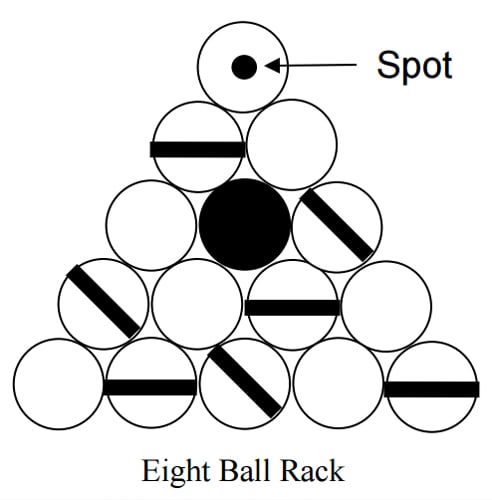
Eight ball is played with fifteen numbered object balls and the cue ball. The shooter’s group of seven balls (one through seven or nine through fifteen) must all be off the table before he attempts to pocket the eight ball to win. Shots are called.
3.1 Determining First Break
The player winning the lag has the option to determine who has to execute the first break shot. (See 1.2 Lagging to Determine Order of Play.) The standard format is alternate break (See Regulation 16, Subsequent Break Shots.)
3.2 Eight Ball Rack
The fifteen object balls are racked as tightly as possible in a triangle, with the apex ball on the foot spot and the eight ball as the first ball that is directly below the apex ball. One from each group of seven will be on the two lower corners of the triangle. The other balls are placed in the triangle without purposeful or intentional pattern.
3.3 Break Shot
The following rules apply to the break shot:
(a) The cue ball begins in hand behind the head string.
(b) No ball is called, and the cue ball is not required to hit any particular object ball first.
(c) If the breaker pockets a ball and does not foul, he continues at the table, and the table remains open. (See 3.4 Open Table / Choosing Groups.)
d) If no object ball is pocketed, at least four object balls must be driven to one or more rails, or the shot results in an illegal break, and the incoming player has the option of
(1) accepting the table in position, or
(2) re-racking and breaking, or
(3) re-racking and allowing the offending player to break again.
(e) Pocketing the eight ball on a legal break shot is not a foul. If the eight ball is pocketed, the
breaker has the option of
(1) re-spotting the eight ball and accepting the balls in position, or
(2) re-breaking.
(f) If the breaker pockets the eight ball and scratches (see definition 8.6 Scratch), the opponent has the option of:
(1) re-spotting the eight ball and shooting with cue ball in hand behind the head string;
or
(2) re-breaking.
(g) If any object ball is driven off the table on a break shot, it is a foul; such balls remain out of play (except the eight ball which is re-spotted); and the incoming player has the option of
(1) accepting the table in position, or
(2) taking cue ball in hand behind the head string.
(h) If the breaker fouls in any manner not listed above, the following player has the option of
(1) accepting the balls in position, or
(2) taking cue ball in hand behind the head string.
3.4 Open Table / Choosing Groups
Before groups are determined, the table is said to be “open,” and before each shot, the shooter must call his intended ball. If the shooter legally pockets his called ball, the corresponding group becomes his, and his opponent is assigned the other group. If he fails to legally pocket his called ball, the table remains open and play passes to the other player. When the table is “open”, any object ball may be struck first except the eight ball.
3.5 Continuing Play
The shooter remains at the table as long as he continues to legally pocket called balls, or he wins the rack by pocketing the eight ball.
3.6 Shots Required to Be Called
On each shot except the break, shots must be called as explained in 1.6 Standard Call Shot. The eight ball may be called only after the shot on which the shooter’s group has been cleared from the table. The shooter may call “safety” in which case play passes to the opponent at the end of the shot and any object ball pocketed on the safety remains pocketed. (See 8.17 Safety Shot.)
3.7 Spotting Balls
If the eight ball is pocketed or driven off the table on the break, it will be spotted or the balls will be re-racked. (See 3.3 Break Shot and 1.4 Spotting Balls.) No other object ball is ever spotted.
3.8 Losing the Rack
The shooter loses if he
(a) pockets the eight ball and fouls.;
(b) pockets the eight ball before his group is cleared;
(c) pockets the eight ball in an uncalled pocket; or
(d) drives the eight ball off the table.
These do not apply to the break shot. (See 3.3 Break Shot.)
3.9 Standard Fouls
If the shooter commits a foul, play passes to his opponent. The cue ball is in hand, and the incoming player may place it anywhere on the playing surface. (See 1.5 Cue Ball in Hand.)
The following are standard fouls at eight ball:
6.1 Cue Ball Scratch or off the Table
6.2 Wrong Ball First The first ball contacted by the cue ball on each shot must belong to the shooter’s group, except when the table is open. (See 3.4 Open Table / Choosing Groups).
6.3 No Rail after Contact
6.4 No Foot on Floor
6.5 Ball Driven off the Table (See 3.7 Spotting Balls.)
6.6 Touched Ball
6.7 Double Hit / Frozen Balls
6.8 Push Shot
6.9 Balls Still Moving
6.10 Bad Cue Ball Placement
6.11 Bad Play from Behind the Head String
6.12 Cue Stick on the Table
6.13 Playing out of Turn
6.14 Three Consecutive Fouls
6.15 Slow Play
6.16 Ball Rack Template Foul
3.10 Serious Fouls
The fouls listed under 3.8 Losing the Rack are penalized by the loss of the current rack. For 6.17 Unsportsmanlike Conduct, the referee will choose a penalty appropriate given the nature of the offense.
3.11 Stalemate
If a stalemate occurs (see 1.12 Stalemate), the original breaker of the rack will break again.
(Sections 4 and 5 excluded here as they cover other game variants)
6. Fouls
The following actions are fouls at pool when included in the specific rules of the game being played. If several fouls occur on one shot, only the most serious one is enforced. If a foul is not called before the next shot begins, the foul is assumed not to have happened.
6.1 Cue Ball Scratch or off the Table
If the cue ball is pocketed or driven off the table, the shot is a foul. See 8.3 Ball Pocketed and 8.5 Driven off the Table.
6.2 Wrong Ball First
In those games which require the first object ball struck to be a particular ball or one of a group of balls, it is a foul for the cue ball to first contact any other ball.
6.3 No Rail after Contact
If no ball is pocketed on a shot, the cue ball must contact an object ball, and after that contact at least one ball (cue ball or any object ball) must be driven to a rail, or the shot is a foul. (See 8.4 Driven to a Rail.)
6.4 No Foot on Floor
If the shooter does not have at least one foot touching the floor at the instant the tip contacts the cue ball, the shot is a foul.
6.5 Ball Driven off the Table
It is a foul to drive an object ball off the table. Whether that ball is spotted depends on the rules of the game. (See 8.5 Driven off the Table.)
6.6 Touched Ball
It is a foul to touch, move or change the path of any object ball except by the normal ball-to-ball contacts during shots. It is a foul to touch, move or change the path of the cue ball except when it is in hand or by the normal tip-to-ball forward stroke contact of a shot. The shooter is responsible for the equipment he controls at the table, such as chalk, bridges, clothing, his hair, parts of his body, and the cue ball when it is in hand, that may be involved in such fouls. If such a foul is accidental, it is a standard foul, but if it is intentional, it is 6.17 Unsportsmanlike Conduct.
6.7 Double Hit / Frozen Balls
If the cue stick contacts the cue ball more than once on a shot, the shot is a foul. If the cue ball is close to but not touching an object ball and the cue tip is still on the cue ball when the cue ball contacts that object ball, the shot is a foul. If the cue ball is very close to an object ball, and the shooter barely grazes that object ball on the shot, the shot is assumed not to violate the first paragraph of this rule, even though the tip is arguably still on the cue ball when ball-ball contact is made.
However, if the cue ball is touching an object ball at the start of the shot, it is legal to shoot towards or partly into that ball (provided it is a legal target within the rules of the game) and if the object ball is moved by such a shot, it is considered to have been contacted by the cue ball. (Even though it may be legal to shoot towards such a touching or “frozen” ball, care must be taken not to violate the rules in the first paragraph if there are additional balls close by.)
The cue ball is assumed not to be touching any ball unless it is declared touching by the referee or opponent. It is the shooter’s responsibility to get the declaration before the shot. Playing away from a frozen ball does not constitute having hit that ball unless specified in the rules of the game.
6.8 Push Shot
It is a foul to prolong tip-to-cue-ball contact beyond that seen in normal shots.
6.9 Balls Still Moving
It is a foul to begin a shot while any ball in play is moving or spinning.
6.10 Bad Cue Ball Placement
When the cue ball is in hand and restricted to the area behind the head string, it is a foul to play the cue ball from on or below the head string. If the shooter is uncertain whether the cue ball has been placed behind the head string, he may ask the referee for a determination.
6.11 Bad Play from Behind the Head String
When the cue ball is in hand behind the head string, and the first ball the cue ball contacts is also behind the head string, the shot is a foul unless the cue ball crosses the head string before that contact. If such a shot is intentional, it is unsportsmanlike conduct.
The cue ball must either cross the head string or contact a ball in front of or on the head string or the shot is a foul, and the cue ball is in hand for the following player according to the rules of the specific game. If such shot is intentional, it is also unsportsmanlike conduct.
6.12 Cue Stick on the Table
If the shooter uses his cue stick in order to align a shot by placing it on the table without having a hand on the stick, it is a foul.
6.13 Playing out of Turn
It is a standard foul to unintentionally play out of turn. Normally, the balls will be played from the position left by the mistaken play. If a player intentionally plays out of turn, it should be treated like 6.17 Unsportsmanlike Conduct.
6.14 Three Consecutive Fouls
If a player fouls three times without making an intervening legal shot, it is a serious foul. In games scored by the rack, such as nine ball, the fouls must be in a single rack. Some games such as eight ball do not include this rule.
The referee must warn a shooter who is on two fouls when he comes to the table that he is on two fouls. Otherwise a possible third foul will be considered to be only the second.
6.15 Slow Play
If the referee feels that a player is playing too slowly, he may advise that player to speed up his play. If the player does not speed up, the referee may impose a shot clock on that match that applies to both players. If the shooter exceeds the time limit specified for the tournament, a standard foul will be called and the incoming player is rewarded according to the rules applicable to the game being played. (Rule 6.17 Unsportsmanlike Conduct may also apply.)
6.16 Ball Rack Template Foul
It is a foul when a Ball Rack Template, removed from the playing surface, interferes with the game i.e. if the template is lying on the rail and a ball (cue or object ball) touches the template that is lying on the rail.
6.17 Unsportsmanlike Conduct
The normal penalty for unsportsmanlike conduct is the same as for a serious foul, but the referee may impose a penalty depending on his judgment of the conduct. Among other penalties possible are a warning; a standard-foul penalty, which will count as part of a threefoul sequence if applicable; a serious-foul penalty; loss of a rack, set or match; ejection from the competition possibly with forfeiture of all prizes, trophies and standings points.
Unsportsmanlike conduct is any intentional behavior that brings disrepute to the sport or which disrupts or changes the game to the extent that it cannot be played fairly. It includes
(a) distracting the opponent;
(b) changing the position of the balls in play other than by a shot;
(c) playing a shot by intentionally miscuing;
(d) continuing to play after a foul has been called or play has been suspended;
(e) practicing during a match;
(f) marking the table;
(g) delay of the game; and
(h) using equipment inappropriately.
7. Rules/Regulations for Wheelchair Competition
7.1 Player’s Eligibility
The criteria for a player to be eligible for Wheelchair competition is that he must be wheelchair mobility dependent for a minimum of 80% of the time. In some cases, a doctor’s letter may be required to determine eligibility.
7.2 Violations Resulting in Fouls
(a) The shooter must remain seated while playing a shot (at least one cheek on the seat or seat pad). If a seat pad is used, it must remain flat and cover the seat of the wheelchair evenly. The seat pad cannot be bunched up on the seat straddled by the shooter with the shooter’s legs or stumps. The shooter may not sit on the wheel or armrest. The point where the shooter’s buttocks rest on the seat or seat pad must not be higher than 27 in / 68.5 cm from the surface on which the wheelchair rolls in its normal operating position.
(b) Players must not have their foot/feet on the floor while playing a shot. Players must not use their legs or stumps as a leverage against any part of the table or the wheelchair while playing a shot.
(c) Players are permitted to use any help aids such as cue extensions, special bridges, etc. Players may not be assisted when actually shooting (however, another person may hold the bridge, but must not help with the stroke of the cue). If a player requires assistance to roll around the table, another person may help them, but must not be touching the wheelchair during the actual shot.
Violations of the above are considered to violate 6.17 Unsportsmanlike Conduct and will typically be penalized as follows: 1st offense, cue ball in hand for the opponent anywhere on the table; 2nd offense, loss of the current game; 3rd offense, loss of the match. The referee may choose a different penalty depending on the nature of the offense.
7.3 Wheelchair Requirements
No standing wheelchairs may be used in the standing position. A player’s wheelchair should be clean and in good working order.
8. Definitions Used in the Rules
The following definitions apply throughout these rules.
8.1 Parts of the Table
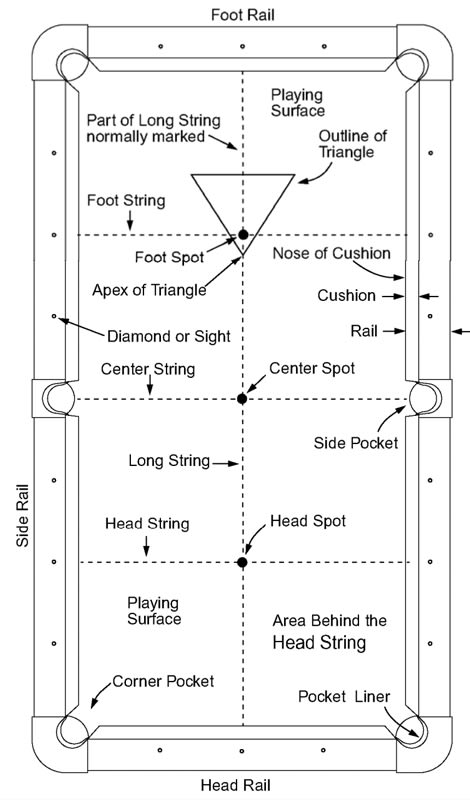
The following definitions of parts of the table refer to the accompanying diagram. Some details of exact size and placement are in the WPA Equipment Specifications. See the WPA website at www.wpa-pool.com for current information.
The table is comprised of rails, cushions, a playing surface and pockets. The foot end of the table is where the object balls usually begin, while the head end is where the cue ball usually
begins. Behind the head string is the area between the head rail and the head string, not including the head string.
The cushions, tops of the rails, pockets and pocket liners are parts of the rails. There are four “strings” on the playing surface as shown in the diagram: the long string down the center of the table; the head string bounding the quarter of the table closest to the head rail; the foot string bounding the quarter of the table closest to the foot rail; and the center string between the two side pockets. These lines are only marked as mentioned below.
The rails may have inlays referred to as diamonds or sights which mark 1/4th of the width and 1/8th of the length of the table measured from nose to nose on the cushions.
On the playing surface, which is the flat, cloth-covered part of the table, the following will be marked if they are used in the game being played: the foot spot, where the foot string and the long string meet; the head spot, where the head string and the long string meet; the center spot, where the center string and the long string meet; the head string; the long string between the foot spot and the foot rail; and the triangle, either in outline or by alignment marks depending on the game.
8.2 Shot
A shot begins when the tip contacts the cue ball due to a forward stroke motion of the cue stick. A shot ends when all balls in play have stopped moving and spinning. A shot is said to be legal if the shooter did not foul during the shot.
8.3 Ball Pocketed
A ball is pocketed if it comes to rest in a pocket below the playing surface or enters the ball return system. A ball near the brink of a pocket partly supported by another ball is considered pocketed if removal of the supporting ball would cause the ball to fall into the pocket. If a ball stops near the edge of a pocket, and remains apparently motionless for five seconds, it is not considered pocketed if it later falls into the pocket by itself. See 1.7 Balls Settling for other details. During that five second period, the referee should ensure that no other shot is taken. An object ball that rebounds from a pocket back onto the playing surface is not a pocketed ball. If the cue ball contacts an already pocketed ball, the cue ball will be considered pocketed whether it rebounds from the pocket or not. The referee will remove pocketed object balls from full or nearly full pockets, but it is the shooter’s responsibility to see that this duty is performed.
8.4 Driven to a Rail
A ball is said to be driven to a rail if it is not touching that rail and then touches that rail. A ball touching a rail at the start of a shot (said to be “frozen” to the rail) is not considered driven to that rail unless it leaves the rail and returns. A ball that is pocketed or driven off the table is also considered to have been driven to a rail. A ball is assumed not to be frozen to any rail unless it is declared frozen by the referee, the shooter, or the opponent. See also Regulation 29, Calling Frozen Balls.
8.5 Driven off the Table A ball is considered driven off the table if it comes to rest other than on the playing surface but is not pocketed. A ball is also considered driven off the table if it would have been driven off the table except for striking an object such as a light fixture, piece of chalk or a player which causes it to return to the table. A ball that contacts the top of the rail is not considered to have been driven off the table if it returns to the playing surface or enters a pocket.
8.6 Scratch
A shot on which the cue ball is pocketed is called a scratch.
8.7 Cue Ball
The cue ball is the ball that is struck by the shooter at the beginning of a shot. It is traditionally white, but may be marked by a logo or spots. In pocket billiard games, a single cue ball is used by both players.
8.8 Object Balls
The object balls are struck by the cue ball with the usual intent of driving them into pockets. They are typically numbered from one to the number of balls used in the game. Colors and markings of the object balls are covered under the WPA Equipment Specifications.
8.9 Set
In some matches, the match is divided into parts called sets, with a certain number of sets won required to win the match. In turn, a certain number of points or racks won is required to win each set.
8.10 Rack
The rack is the framing device, typically triangular, used to arrange the object balls for the break shot at the start of the game. It also refers to the group of balls so arranged. To rack the object balls is to group them with the rack. A rack is also a portion of a match played with a single rack of object balls. Some games, such as nine ball, are scored at one point per rack.
8.11 Break
A break shot is the opening shot of a match or rack, depending on the game. It happens when the object balls have been racked and the cue ball is played from behind the head string usually with the intent of breaking the rack apart.
8.12 Inning
An inning is a player’s turn at the table. It begins when it is legal for him to take a shot, and ends at the end of a shot when it is no longer legal for him to take a shot. In some games a player may choose not to come to the table in certain situations when play would normally pass to him, and then the player remaining at the table continues the inning (e.g. a push-out at nine ball). The player whose turn it is to play is called the “shooter.”
8.13 Position of Balls
The position of a ball is determined by the projection of its center vertically downward onto the playing surface. A ball is said to be placed on a line or spot when its center is placed directly over that line or spot.
8.14 Re-spotting Balls
In some games, object balls are required to be placed on the playing surface other than when forming a new rack. They are said to be re-spotted when they are so placed. See 1.4 Spotting Balls.
8.15 Restoring a Position
If the balls are disturbed, the rules of the game may require them to be replaced where they were. The referee will replace the balls to their original position as accurately as possible.
8.16 Jump Shot
A jump shot is one in which the cue ball is made to go over an intervening obstacle such as an object ball or part of the cushion. Whether such a shot is legal depends on how it is accomplished and the intention of the shooter. Usually a legal jump shot is played by elevating the cue stick and driving the cue ball down into the playing surface from which it rebounds.
8.17 Safety Shot
A shot is said to be a safety shot if the game in play is a call shot game and the shooter declared the shot to the referee or his opponent to be a “safety” before the shot. Play passes to the other player at the end of a safety shot.
8.18 Miscue
A miscue occurs when the cue tip slides off the cue ball possibly due to a contact that is too eccentric or to insufficient chalk on the tip. It is usually accompanied by a sharp sound and evidenced by a discoloration of the tip. Although some miscues involve contact of the side of the cue stick with the cue ball, unless such contact is clearly visible, it is assumed not to have occurred. A scoop shot, in which the cue tip contacts the playing surface and the cue ball at the same time and this causes the cue ball to rise off the cloth, is treated like a miscue. Note that intentional miscues are covered by 6.17 Unsportsmanlike Conduct (c).
 Download WPA Eight Ball Rules...
Download WPA Eight Ball Rules...
Sources:
Blackball: http://www.blackball.uk/2016/02/blackball-rules-visual-guide.html
EPA World Rules: http://www.epa.org.uk/wrules.php
WPA World Rules: http://wpapool.com/rules-of-play/
